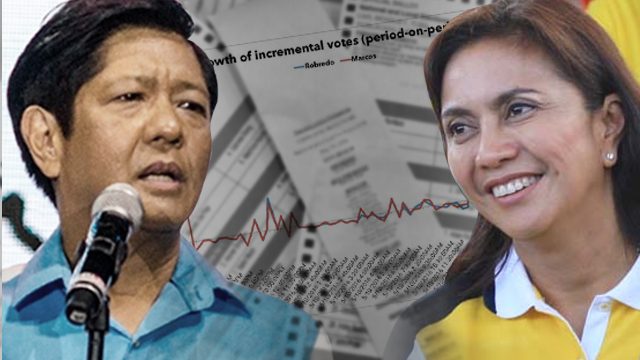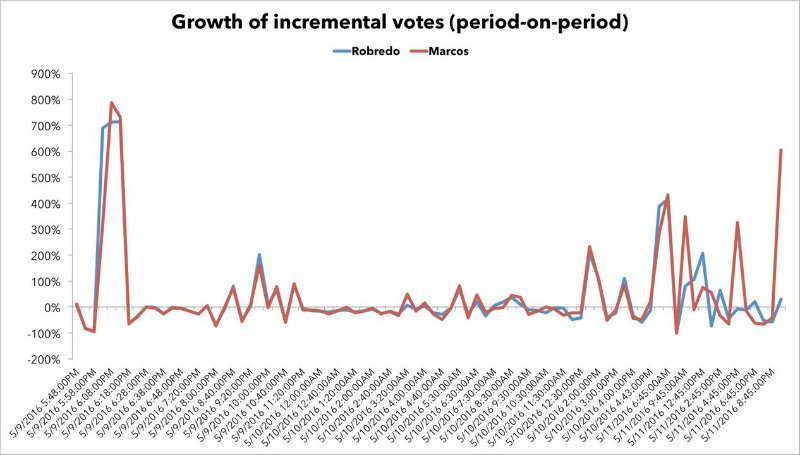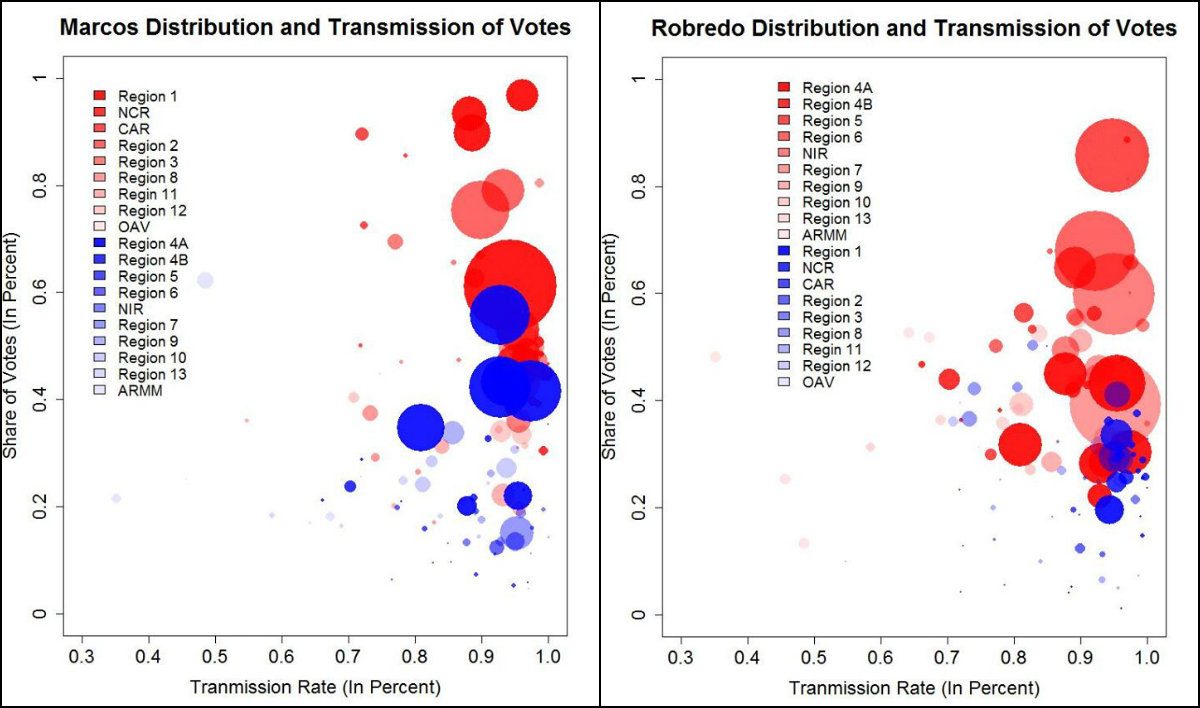SUMMARY
This is AI generated summarization, which may have errors. For context, always refer to the full article.

MANILA, Philippines – From mudslinging to math-slaying.
This is how netizens are describing the social media posts of several math experts trying to make sense of the data explaining Camarines Sur 3rd District Representative Leni Robredo’s rise in the vice presidential race.
Vice presidential bet Senator Ferdinand “Bongbong” Marcos Jr initially led the race during the first few hours of the transmission of election results on May 9, based on the Comelec-GMA7 Mirror server.
By 3:40 am of May 10, however, Robredo snatched the top spot from Marcos.
The sudden surge of Robredo in the race, according to Marcos, amounts to “strange developments.” Marcos quickly alleged the possibility of cheating in the unofficial results. (READ: Unyielding Marcos says Robredo’s rise in tally ‘strange’)
“It was a very measured increase in the votes that doesn’t seem to follow what our internal surveys are saying,” he explained.
Marcos also insinuated dagdag-bawas (point shaving) by citing two reports where Senator Francis “Chiz” Escudero lost more than 30,000 votes at the time Robredo earned the same number of votes. The Marcos camp insisted on the allegation even after GMA-7 and CNN Philippines had already apologized and said they had committed a typographical error.
Fortunately, various Filipino math experts were quick to provide possible explanations to the trend.
Too good to be true?
There are two fundamentally opposing mathematical interpretations that have surfaced on social media: one backing up the cheating allegation, and another refuting the claim.
Is Robredo’s rise a result of cheating? The almost perfect trendline, according to David Yap, a former instructor of the Ateneo de Manila University and Antonio Contreras of the De La Salle University, is suspicious. (Editor’s note: An earlier version of this story referred to Antonio Cotreras as Alvin Contreras. We made the necessary changes. We apologize for the error)
Employing a trendline on the rise and fall of Marcos in the unofficial results, Yap and Contreras said that the equation resulted to an almost perfect line.
“My mathematical side tells me that when increases and decreases in votes that are supposed to be coming randomly from diverse areas in the country with different political preferences become a straight line, then reaches a point where it is reversed, that something might have been programmed,” Contreras said.
In his analysis, Contreras also assumed that “bailiwick votes could not be used to explain the sudden downward trend of the lead of Marcos over Robredo, considering he is also strong in Region 8 in the Visayas, and Regions 11 in Mindanao.”
Yap’s analysis particularly triggered a flurry of counter-interpretations from experts in the fields of statistics and mathematics.
Yap was scheduled to give a talk entitled “Analysis of Voting Patterns in the Vice-Presidential Race” on Friday, May 13, at the UP School of Statistics, but the forum was cancelled at the request of Yap, who cited “concerns about his security.”
‘Misguided assumption’
Many mathematicians and statistical experts said that the model used by Yap and Contreras does not provide the best method to interpret the unofficial results, especially because it uses cumulative data.
Filipino MA student at Columbia University Arnold Lau, UPSE PhD candidate Adrian Mendoza, and UPSS assistant professor Peter Julian Cayton – among other math experts – agreed with this.
In his analysis, Jan Carlo Punongbayan also said that Yap and Contreras’ interpretation is anchored on a critical misguided assumption: supposed randomness of the transmission of election results.
Punongbayan is currently a PhD student at the UP School of Economics, where he also graduated summa cum laude and valedictorian in 2009. He also served as the Head Executive Assistant at the National Economic and Development Authority from 2014-2015.

Instead of analyzing the unofficial result by looking into the linear trends of the gap, Punongbayan examined the growth rates, their moving averages, and their correlations.
The graph produced by Punongbayan showed that the growth rates of both Marcos’ and Robredo’s votes actually showed similar patterns.
“Whatever advantage Leni has derived thus far into the race came from the accumulation of very small gaps between these otherwise highly correlated growth rates,” Punongbayan added.
Punongbayan further broke down the data by taking the moving average over time. It reflected the same result: “There does not seem to be any evidence to suggest that at any point of the race Leni’s votes grew disproportionately vis-à-vis the growth of Bongbong’s votes.”
Logarithmic trend and common sense
Miguel Barretto Garcia echoed this, saying that “what Yap and Contreras may have forgotten to factor into their analysis is the transmission rate of the votes.” Garcia is currently a Filipino PhD student at the University of Zurich.
“The assumption of randomness does not hold because we are looking at aggregate data and the rate of transmission of votes has a systematic rate of increase: a logarithmic one,” Garcia said. Meaning, the increase of votes is exponential and when visualized shows a curve in the graph.

“Why transmissions behave in a logarithmic manner has a very simple explanation: Luzon and Metro Manila votes (which heavily favored Marcos) came in early and it quickly reached above 90% transmission in the evening of May 9. On the other hand, the Visayas and Mindanao votes transmitted data at a much slower rate, especially if you happen to live in far flung islands or in areas with dense forests,” Garcia added.
The graphs produced by Garcia showed that Marcos’ early lead in the unofficial results may be attributed to the early reporting of areas where he led by wide margins – most of them provinces from Luzon.
Marcos is banking on the “Solid North” to win the country’s second-highest elective post. The “Solid North” refers to the Ilocos region and nearby provinces. (READ: Which home provinces delivered for presidential, VP candidates?)
This analysis is simulated here.
Echoing the same argument in simpler terms. Reina Reyes, the Filipina scientist who proved Einstein right, stressed that “the votes did not come in randomly. This much is clear from the data/common sense/news reports, that assuming otherwise must be disingenuous, while ironically claiming authority through technical jargon.”
“You can see how the dramatic overtake is clearly driven by votes coming in from Visayas and Mindanao,” suggesting that in the end, it is simply about geography.
Analysis and solutions
Responding to the variety of mathematical interpretations, political analyst Clarissa David warned readers against “experts” claiming to be able to prove cheating through graphs and analyses.
“There is a right and wrong way of doing analysis. It starts with the humility and foresight to know and state assumptions. No amount of data analysis will make up for incorrect assumptions,” David added.
On Thursday, May 12, Comelec Chairman Andres Bautista denied that cheating took place. He said that the change in the hash code of the data package containing election results was merely “cosmetic” in nature.
Comelec Commissioner Christian Lim added that the hash code issue has been blown out of proportion.
Marcos is trailing Robredo in the unofficial tally as of 9:34 pm on Thursday. Robredo has 13.99 million votes as opposed to Marcos’ 13.76 million. – Rappler.com
Add a comment
How does this make you feel?
There are no comments yet. Add your comment to start the conversation.